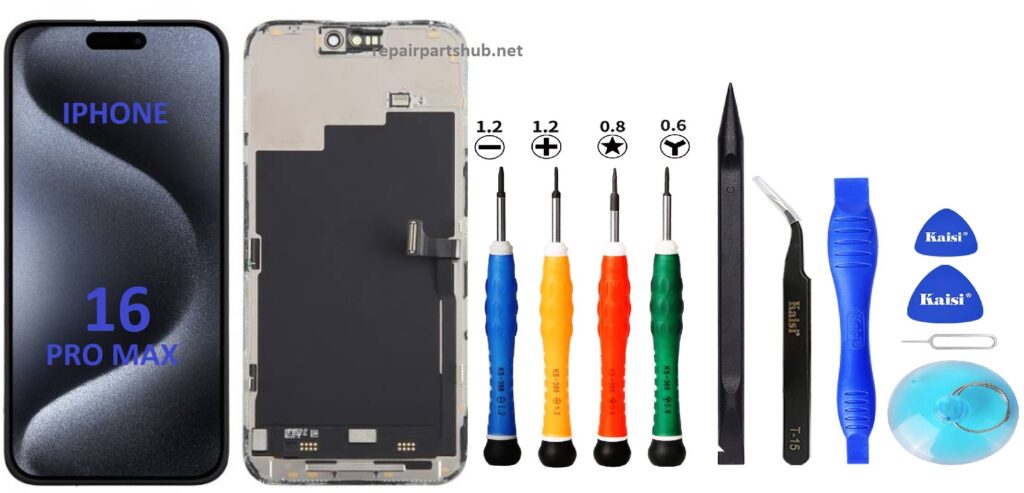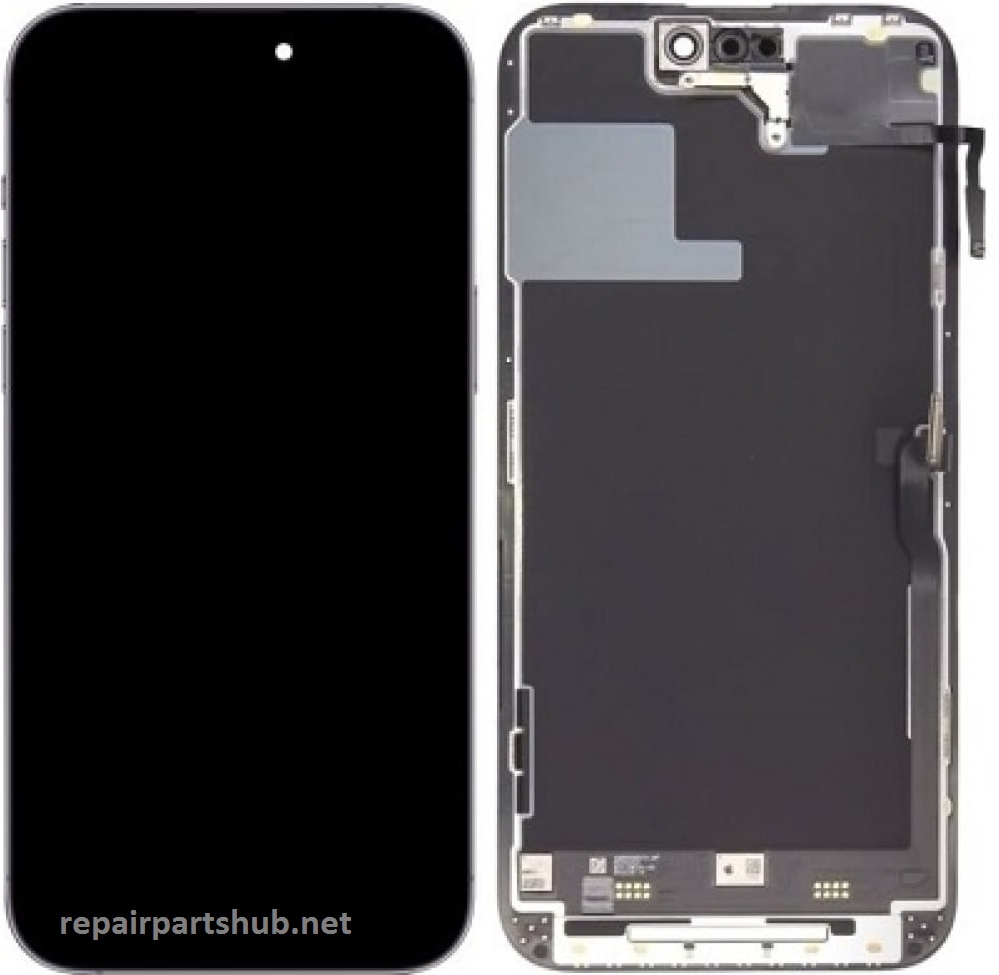
The iPhone 16 Pro Max represents the latest in Apple’s evolution of high-end smartphones, pushing the boundaries in terms of design, functionality, and display technology. While full details are still to be confirmed, there are several educated predictions regarding the LCD screen (likely OLED/mini-LED), the size of the display, and the tools required for maintenance and repair. Below, we provide an in-depth analysis of each aspect.
LCD Screen Description:
While the iPhone 16 Pro Max is likely to feature an OLED or mini-LED screen (and not a traditional LCD, as the term is sometimes incorrectly used), it will still carry forward Apple’s strong legacy of display technology. The transition from traditional LCD panels to OLED has been one of the standout features of Apple’s flagship devices in recent years, with OLED offering enhanced color accuracy, better contrast ratios, and improved energy efficiency. Here’s a breakdown of what to expect:
Display Technology:
- OLED or Mini-LED Display: The iPhone 16 Pro Max will likely continue using OLED (Organic Light Emitting Diode) or possibly transition to a mini-LED screen. Mini-LED is a technology that uses smaller LEDs to offer greater precision and local dimming control for an enhanced contrast ratio, perfect for HDR (High Dynamic Range) content. If the iPhone 16 Pro Max opts for mini-LED, users can expect improved black levels and more vibrant colors compared to standard OLED displays.
- Super Retina XDR Display: Similar to the iPhone 14 and 15 series, the iPhone 16 Pro Max is expected to feature a Super Retina XDR display. This display standard ensures incredibly vibrant colors, exceptional contrast, and an ultra-high-definition viewing experience. The XDR (Extreme Dynamic Range) branding guarantees better contrast, more realistic colors, and deeper blacks than previous models. Expect to see HDR10 and Dolby Vision support for the best multimedia experience.
Color Accuracy and Brightness:
The iPhone 16 Pro Max will most likely feature:
- Wide Color Gamut (P3): Apple’s commitment to color accuracy means that the display will cover a wide color spectrum, allowing for incredibly precise and realistic color reproduction. This is especially beneficial for photographers, designers, and video editors who rely on their devices for professional-grade work.
- True Tone: This feature will dynamically adjust the white balance to match the ambient lighting, ensuring that colors remain consistent regardless of the environment.
- Brightness and HDR Performance: The brightness levels on the iPhone 16 Pro Max will likely be significantly higher than those seen on its predecessors. Expect peak brightness levels of up to 1600 nits or higher for HDR content, with typical brightness around 1000 nits for normal usage. This enhanced brightness makes it much easier to use the phone in direct sunlight, ensuring readability even in bright environments.
Resolution and Pixel Density:
- Resolution: The iPhone 16 Pro Max will likely sport a high-resolution display around 2778 x 1284 pixels or higher, ensuring that every detail appears sharp and clear. This translates into a pixel density of over 460 ppi (pixels per inch), which means incredibly fine details are rendered crisply.
- Refresh Rate: The device will undoubtedly support a 120Hz ProMotion refresh rate, offering smooth animations and a fluid experience. This feature makes a significant difference when scrolling, gaming, and interacting with the device. ProMotion reduces the perceptible stutter or blur that can occur with lower refresh rates, contributing to a seamless user experience. The refresh rate could be dynamically adjusted, switching between 60Hz and 120Hz based on the content being displayed, in order to save battery life.
Screen Size:

The iPhone 16 Pro Max is likely to maintain its dominant size in the market:
- Screen Size: The display will likely measure around 6.7 inches, offering ample screen real estate for productivity, media consumption, and gaming. For users seeking the latest in cutting-edge displays, the larger screen size ensures more immersive video watching, gaming, and multitasking. The iPhone 16 Pro Max will continue Apple’s trend of offering near edge-to-edge displays, with the screen stretching to the edges of the device, ensuring minimal bezels and maximizing the available area for the screen.
- Aspect Ratio: The 19.5:9 aspect ratio will likely remain, ensuring a tall and slim display that is excellent for multimedia content and web browsing. This aspect ratio is ideal for both video content (which is often shot in widescreen formats) and productivity, such as document reading or app multitasking.
- Form Factor: While the screen itself will be large, the iPhone 16 Pro Max may feature a slightly reduced notch (or even no notch if under-display camera technology is employed) in the front. This would allow for more screen space and a sleeker, modern look. In addition, Apple may further reduce the bezel thickness around the display to provide an even more immersive screen experience.
Durability:
Apple continues to enhance the durability of its displays. The iPhone 16 Pro Max is expected to feature Ceramic Shield, a toughened glass developed in collaboration with Corning, which will make the screen more resistant to scratches and drops. The glass is said to be tougher than traditional glass, providing extra protection for those moments when you accidentally drop your device.
Tools for Repair and Maintenance:
Repairing or replacing the iPhone 16 Pro Max screen, due to the advanced materials and technology involved, requires specialized tools and a delicate approach. Here is a detailed overview of the tools typically used:
- Pentalobe Screwdriver: This tool is necessary for removing the screws located around the perimeter of the iPhone 16 Pro Max. Pentalobe screws are Apple’s proprietary screws, so the right tool is essential to avoid damage.
- Suction Cup Tool: A suction cup is required to safely lift the glass screen away from the body of the iPhone without cracking the display or damaging internal components. Given the adhesive used, the screen might be challenging to remove without proper lifting.
- Plastic Pry Tools and Spudger: These tools are designed to gently separate the screen from the device. The spudger tool is particularly useful for detaching connectors and carefully maneuvering the device’s internal parts, while the plastic pry tools allow you to break through adhesive seals without damaging the glass or internal components.
- Heat Gun or Heating Pad: To soften the adhesive used to attach the screen to the phone, a heat gun or a heating pad may be used to warm up the adhesive around the edges of the screen, making the removal process easier and reducing the risk of damage.
- LCD Separator Machine: This specialized machine is used when replacing or separating the display from the body of the phone, ensuring the adhesive is softened and the screen can be removed cleanly and safely.
- ESD (Electrostatic Discharge) Wrist Strap: This tool is essential for protecting the delicate internal electronics of the iPhone 16 Pro Max from static electricity, which could cause irreparable damage to components.
- Adhesive Strips or Glue: When reassembling the phone, specialized adhesive strips or glue are used to secure the new display back in place. These adhesives are designed for strength and durability while maintaining the sleek appearance of the iPhone.
Repair and Replacement Challenges:
Replacing the iPhone 16 Pro Max screen is a complex and delicate procedure, especially as modern smartphones continue to feature thinner designs, larger screens, and more fragile components. Because Apple employs advanced adhesives and intricate assembly processes, many users opt for professional repairs to avoid voiding warranties or risking further damage. Apple’s Face ID technology, which involves the TrueDepth camera system, may also complicate repairs as it could require special calibration after screen replacement to ensure the device’s biometric features work properly.
Conclusion:
The iPhone 16 Pro Max will likely feature a 6.7-inch Super Retina XDR OLED or mini-LED display that delivers exceptional brightness, color accuracy, and contrast. The screen will maintain the impressive quality of previous iPhone models, but with incremental improvements, especially in brightness, refresh rate, and power efficiency. The larger display will cater to media lovers and multitaskers, and the tools required for screen repair will reflect the high degree of technical expertise necessary to handle this advanced piece of technology. All in all, the iPhone 16 Pro Max’s display will continue to set the standard for premium smartphone screens, with improvements in durability, color reproduction, and overall viewing experience.